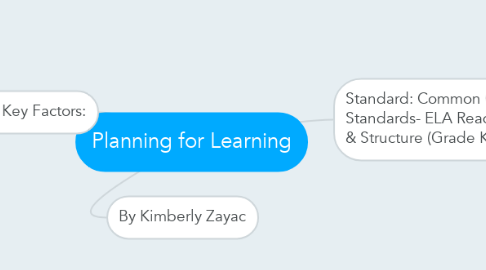
1. By Kimberly Zayac
2. Students- Key Factors:
2.1. 1. Advanced Students: Provide additional/more difficult classwork/homework in relation to the unit information. Have these students pair with struggling students/be a helper to those who need it
2.2. 2. On Level Students: Students will complete the grade-level work in classroom
2.3. 3. Approaching Level Students: Pair students with students who are at/above grade level for unit information; monitor closely for struggles/progress that may need addressing
2.4. 4. Special Needs Students: Provide paperwork for student to do with resource room teacher that goes along with the unit
3. Standard: Common Core State Standards- ELA Reading- Craft & Structure (Grade K)
3.1. Objectives:
3.1.1. 1. Students should be able to identify and name the author/illustrator of a given story (90% accuracy)
3.1.2. 2. Students should be able to define the role of the author/illustrator in a given story (90% accuracy)
3.1.3. 3. Students should be able to name and describe various common types of text (i.e. poems, works of fiction, nonfiction, fables, etc.) (80% accuracy)
3.2. Big Ideas:
3.2.1. 1. Types of Text: students will discover and learn about various types of text common in kindergarten, such as fiction and nonfiction, fables, fairytales, poems, etc.
3.2.2. 2. Author/Illustrator: students will be able to identify the placement of the author and illustrator in a given story, as well as describing the roles of both author and illustrator in a given story.
3.2.3. 3. Asking questions about unknown words: students will encounter words that are unknown to them; students will learn how to ask questions about these words.
3.3. Scaffolding Strategies:
3.3.1. 1. Show and Tell: For Objectives 1 and 2, students should be shown where the author and illustrator of a book are located in a text. (i.e. During reading time every day, the teacher will read students stories and discuss the names and roles of author/illustrator, as well as the placement of these roles in a story book)
3.3.2. 2. Use Visual Aids: For Objective 3, story books should be used to show the location of author/illustrator, as well as to discuss the type of text (poem, fable, etc.). This could be made into a multimedia activity by use of the computer (for example, Wonders is a reading curriculum that involves both physical text and use of electronic resources, like books and videos to involve students.
3.3.3. 3. Intention Small Group/ Partner Work: Group work is a great way for students to test and expand their knowledge (see example attached)
